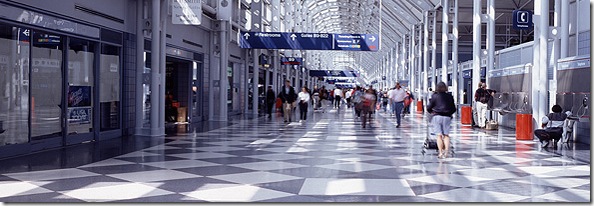Packing for a short trip can seem harder than packing for a long one – you need pretty much all the same stuff, just in smaller amounts. I travel frequently, and have gotten used to packing everything I need in about an hour. Here’s my mental checklist, and a few additions that other people might commonly need, to help take the stress out of your trip to Blizzcon.
Toiletries:
Think about what you do as you get ready in the morning, and as you prep for bed at night. Take a day and think about it as you’re getting ready. Put everything you use in a pile instead of putting it away. That’ll give you a pretty good idea of what you need to bring with you.
- Toothbrush/Toothpaste/Mouthwash

- Contacts case, solution, glasses & case
- Comb/hairbrush
- Deodorant
- Hair styling products: Rubber bands, gel, hairspray, etc.
- Makeup
- Medications/Vitamins
- Shampoo/Conditioner/Soap/Lotion (some of these will be provided by your hotel – so you can probably skip at least the shampoo and soap unless you need something specific)
- Razor/Shaving Cream
Check and see if your hotel has hair dryers available if that’s something you use daily. Most of them take up a lot of space in your bags, and while you can get travel size models, it’s better to not have to buy an extra one that you won’t use much.
Travel size stuff is DEFINITELY worth it, though, when it comes to toiletry products. Check the cosmetics section of your local store for either small sizes of things like toothpaste, shaving cream, and body wash, or for small, empty bottles that you can fill from your larger bottles at home. Post September 11th US Travel Regulations require all liquids in carry-on luggage (do yourself a favor and get a carry on luggage with a TSA approved lock, like https://chestertravels.com/best-carry-on-luggage/) to be 3 oz or less, and for all of your 3 oz. bottles to fit into a single 1 quart zip-top bag. If you have to bring a bigger bottle, you’ll have to put it in a checked bag, rather than a carry on. Some airlines charge extra for ANY checked bags, so if that’s your plan, double check to make sure you won’t have any extra fees.
Clothes:
Are you planning to go to Disney Land? Stay an extra day or two? Do you get cold easily? Do you usually wear sneakers or sandals?
A good rule of thumb here is to wear your bulkiest items on the plane, and pack the smallest ones. If you want to bring both sneakers and flip-flops, pack the sandals, and wear your Nikes. Wear long pants, and pack a pair of shorts. Wear your jacket on the plane. All of this adds up to saved space, and makes it less likely you’ll have to check your bags. (On the other hand, I had a friend who would do this in reverse – she wore her smaller items on the way out, and the big ones on the way back, that way she had built-in room for souvenirs. Pretty clever.)
But how much to bring?
- Bring 1/2 as many pairs of pants as there are days in your trip.
- Bring undergarments, shirts, and socks for each day. (Unless you live in sandals, like I do, then you can bring fewer socks. But you’ll still want at least 1 pair.)
- 1 nicer shirt in case you decide to go somewhere nicer than In-n-Out (Don’t stress about this. California is generally very casual, and a polo or collared shirt with jeans will work for you 90% of places. You don’t need a tie, a blazer, or panty hose.)
- Bring your bathing suit. (your hotel might have a pool, and it sucks to buy a bathing suit in a hurry. Besides, they’re small and pack easily.)
- Pajamas. ESPECIALLY if you have a roommate!!!
Miscellaneous:
- ID – Passport (if coming from outside the US), Drivers’ License, School ID.. .Just something with your photo on it. Bring two, just in case, and keep them in different places.
- Cash. At least $10, never more than $100. (I usually just bring $20, and whatever $1’s have around.)
- Electronics. Camera, iPhone, iPod, Cell, Laptop.
- Business cards, or other way to exchange information quickly
- Breath mints/Gum (You’ll thank me.)
- Your battle.net authenticator. (You might need it to play while you’re there. I’m not sure, but better safe than sorry.)
- Printouts of your barcodes, and the credit card you used to pay for them
Things Everyone Forgets:
Yes, everyone. No, not always. (You have a list!)
- Q-tips
- Cotton balls
- Nail Clippers/File/Tweezers (you CAN take a small pair of nail clippers in your carry on luggage, but don’t bring your nice ones, just in case your security personnel are cantankerous. Bring a cardboard emery board instead of a metal nail file.)
- Sunscreen (for Disney, the Beach, etc.)
- Chargers for your: iPod, Camera, Laptop, etc.
- Shopping list, or presents for guildies. (You know you said you’d bring something for so-and-so. Don’t forget it! You’ll feel like a jerk!)
If you’re wearing a costume:
This isn’t really my area of expertise, but a few things come to mind.
- Duct Tape
- Small Sewing Kit
- Special Make-up and accessories
- More Duct Tape
I realize that some will have more specific needs, but this should cover most people. Feel free to make additions in the comments. The best thing to remember is that Anaheim is not in the middle of nowhere, and if you forget something, you’ll likely be able to get it there. See you soon!!
Luv,
Wyn



